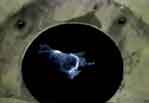MolaKule
Staff member
I have a New Poulan 2-stage snowblower.
I was blowing the snow tonight which was dry and very powdery.
The metal chute which directs the snow is sitting on a plastic turret fitting, so it is insulated.
While throwing snow I noticed a bright blue spark, about a half inch long, sparking between the outside of the metal chute and a close proximity peice of metal, a bracket. It only happened while snow was moving up the chute.
What the heck? Spark plug wire loose or what?
No, plug wire ok, not loose, not shorting.
Throw more snow, more bright blue sparks between the metal chute and adjacent bracket. Auger ok, everything working as it should, no binding no mechanical problem...Engine running great.
OK, this is too good for a physicist or mechanic to NOT investigate.
Anyone have a theory?
I have a theory but wanted to see if anyone else has observed this or has a theory as well.
Mola
I was blowing the snow tonight which was dry and very powdery.
The metal chute which directs the snow is sitting on a plastic turret fitting, so it is insulated.
While throwing snow I noticed a bright blue spark, about a half inch long, sparking between the outside of the metal chute and a close proximity peice of metal, a bracket. It only happened while snow was moving up the chute.
What the heck? Spark plug wire loose or what?
No, plug wire ok, not loose, not shorting.
Throw more snow, more bright blue sparks between the metal chute and adjacent bracket. Auger ok, everything working as it should, no binding no mechanical problem...Engine running great.
OK, this is too good for a physicist or mechanic to NOT investigate.
Anyone have a theory?
I have a theory but wanted to see if anyone else has observed this or has a theory as well.
Mola
Last edited:




